Roquefort pastries
“Nothing like a nice festive sherry to fortify the taste buds,” says Auntie Jean, while quietly drinking a pre-prandial Christmas amontillado. This 11-year old, meanwhile, is helping to trim the sprouts by the sink with Dad, who mutters aside that he’ll soon be pouring himself a gin and French once the bread sauce is put to simmer. I always thought that Dad’s drink was absolute filth: half a tumbler of gin, with the remaining volume topped up with Noilly Prat. No ice. No lemon. And then he will probably sneak in a quick top-up while Mum, my brother, Auntie Jean and I are in the sitting room watching the Queen. All that having been said, our Christmas Day feast was always, but always, quite brilliant.
Like Auntie Jean, amontillado was Mum’s preferred sherry. As for finding a splendidly mature, dry oloroso, the very idea would have been nothing less than ridiculous. Five decades on, it remains the very nicest accompaniment to these cheese pastries. Serve the oloroso lightly chilled, please.
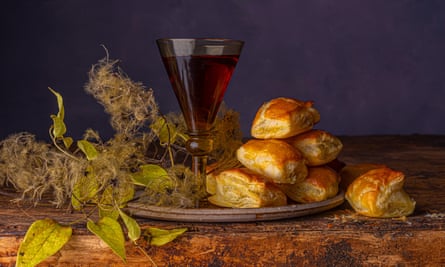
Makes 24
all butter puff pastry 1 x 320g sheet
egg 1, beaten
For the cheese filling
Roquefort cheese 100g
Boursin cheese 80g
egg yolk 1
plain flour 1 scant tbsp
butter 25g
cayenne ¼ tsp
With the long edge of the pastry facing you, cut the sheet of pastry into 4 equal quarters. Then cut each quarter in half, lengthways, to achieve 8 small rectangles
Line a small, shallow tray with greaseproof paper cut to fit (you will need two sheets), then lay upon it 4 pieces of pastry. Cover with the second sheet, then place the remaining four pieces of pastry upon this. Place in the fridge (or more quickly, in the freezer) until firm; this is a good idea if you do not wish the pastry to become unmanageable and too soft (especially if the kitchen is warm) while folding and filling with the cheese mixture.
To make the cheese filling, simply mix the ingredients together until smooth; I use a small food processor, but a whisk should do it. Scrape out into a small container and put to firm up in the fridge for about 30 minutes.
Pre-heat the oven to 200C/gas mark 6.
To assemble, dust a surface with flour, take two pieces of pastry at a time from the fridge (or freezer) and, again, long edge facing, roll each one out a little more – by about 2cm. Working quickly, lightly brush each piece with beaten egg, then put 3 teaspoons (don’t over-fill) of the cheese mixture equally placed along it, allowing a small gap between each spoonful. Deftly fold over the front edge of the pastry to the back, and seal. Using the little finger, gently press down between each mound, including the ends, then cut into 3 equal pieces; I find the most efficient way is to use a crinkled pasta wheel, as one would form ravioli. Line a baking sheet with parchment, lay the 6 pieces out in a line, brush with beaten egg and pierce each piece with a fork. Repeat the process with the remaining 6 pastry pieces.
Bake in the oven for about 20-25 minutes, or until golden and well-puffed; if two or three exude a little filling, don’t despair, as these crunchy bits are just delicious.
Smoked salmon and cucumber mousse
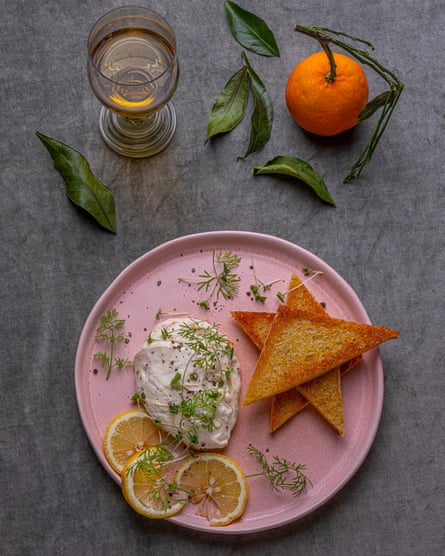
Some may say that this savoury fish mousse does not quite taste enough of fish – and they may be right. But here, the salmon flavour is subtle, quietly carried by cucumber and, chums to both, feathery dill. So many dishes today are mouth-slappingly pushy, whereas this rather dainty and well-behaved fluff – it is very lightly textured – is English cookery to a tee; or as it once used to be … One needs such a thing over what is often a period of relentless riches. Eat it with crisp toast, well buttered, and with fine linen napkins to hand.
Serves 4-6
cucumber ½, peeled and grated
salt 1 scant tsp
smoked salmon 150g
soured cream 100g
cream cheese 100g
cayenne pepper ¼ tsp
dill several small sprigs, fronds removed
gelatine 2 leaves, soaked in cold water until softened
double cream 100ml
egg whites 2
lemon juice 1 tsp
First, mix the cucumber with the salt, place in a colander and leave to drain for at least 30 minutes, suspended over a bowl (you will need the drippings). Meanwhile, put aside 30g of the smoked salmon, finely chop it, put into a small bowl and set aside. Place the remainder of the salmon, roughly chopped, in a small food processor and puree together with the soured cream and cream cheese until smooth. Add the cayenne and dill, then pulse-process until the dill is finely chopped into the mix. Decant into a medium bowl.
Squeeze the excess moisture from the cucumber with your hands, then mix it together well with the chopped salmon. Now, take 2 tablespoons of the salty cucumber water and place in a small saucepan (discard the remaining water). Add to it the soaked gelatine leaves and gently warm through until melted. Leave to cool for a couple of minutes then thoroughly whisk into the creamed salmon. Place the bowl in the fridge until the mixture is beginning to firm up – about 30-40 minutes.
To assemble everything, loosely whip the cream until it is only just holding peaks, then whisk the egg whites with the lemon juice until showing soft peaks. Loosen the creamed salmon mixture by whisking it, while also incorporating the chopped salmon and cucumber until evenly distributed. Finally, gently – but thoroughly – fold in the cream, then quickly and deftly followed by the egg whites. Once a pretty pink and green-speckled homogenous mixture has been achieved, decant into a Tupperware container, fix on the lid and put to chill in the fridge for at least 4 hours.
To serve, dip a tablespoon into a jug of hot water and scoop out a couple of nice spoonfuls onto chilled, pretty plates. Serve just as is, with hot, buttered toast and, if you like, a few sprightly sprigs of watercress, or mustard and cress.
Grilled oysters with pastis and fennel crumbs

This a new dish and, I feel, particularly special for Christmas feasting. There is no question that aniseed flavours are good when paired with hot oysters; just think Rockefeller. Here, however, fennel is used to good effect as a fine puree in the base of the shell, the warmed (just stiffened) oyster placed upon it and then a savoury butter/crumb to finish.
When baked together in the oven until bubbling and crusted, the emerging scent is just marvellous. Try to find medium to small oysters, as it is a good thing if you can eat the cooked oyster from the shell in one complete spoonful.
If you can find some, a little fennel pollen mixed into the crumb is a very good idea.
Note: I suggest that you cook the oysters in two batches, simply because having an oven that will accommodate 24 of them at one time may be impractical. Ergo: eat three each, cook more, repeat.
Serves 4
rock oysters 24, shucked (scrub the shells clean in hot water and reserve)
For the fennel puree
fennel bulbs 2 small, about 400g, reserving any green fronds that are attached
olive oil 1 tbsp
unsalted butter a thick slice
garlic 1 clove, crushed
pastis 1 tbsp
oyster juices
lemon juice of ½
For the savoury butter
unsalted butter 125g, softened
garlic 1 small clove, crushed to a paste
tarragon leaves from 2-3 sprigs, finely chopped
fennel fronds finely chopped
Tabasco 3-4 shakes
pastis 1 scant tbsp
For the fennel crumbs
fresh white breadcrumbs 40g
fennel pollen optional
olive oil or olive-oil spray
Pop the oysters and their juices (strained, to catch any stray bits of shell) into a small pan and warm through over a gentle heat until just stiffened. Lift out with a slotted spoon and put to one side. Reserve the juices.
To make the fennel puree, roughly chop the fennel, put into a saucepan and add all the other ingredients. Place over a moderate heat and bring up to a simmer. Pop on the lid and quietly cook until the fennel is very tender indeed. Remove the lid and cook fairly rapidly over a higher heat so that any liquid is reduced to not much more than a smear. Tip into a small food processor and whizz until very smooth (I use a Nutribullet for best results). Put aside.
Pre-heat an overhead grill to medium-hot.
For the savoury butter, simply whisk all the ingredients together until smooth. Spoon out onto a small piece of foil, roll it into a thick-ish sausage (about 3cm thick) and put in the freezer to firm up.
To assemble, place a heaped teaspoon of fennel puree into the bottom of each shell and then top with an oyster. Remove the butter from the freezer and remove the foil. Using a small sharp knife, cut off thin slices and place one atop each oyster.
Line an oven tray with slightly crumpled foil and arrange 12 oysters upon it. Evenly sprinkle the breadcrumbs over each oyster and trickle a little olive oil over each one (truly, however, for best results, an olive-oil spray will deliver the most even crust to each oyster, once cooked). Grill for 6-7 minutes, or until the oysters are golden crusted and bubbling around the edges. Leave for 5 minutes before eating, to avoid burnt tongues. Repeat with the remaining 12 oysters.
Roast goose stuffed with mashed potato
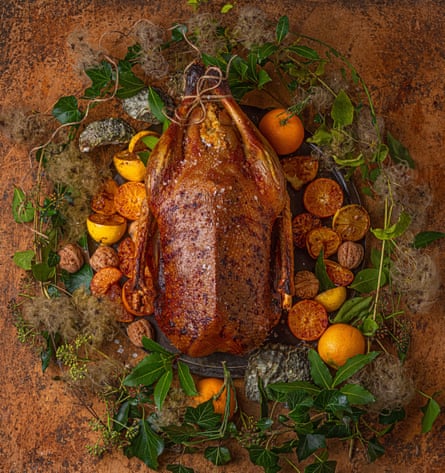
I have never roasted a turkey for Christmas, not once. I have nothing against it and, quite simply, someone else has always been there to do it. The parents did, of course, in childhood and it remains as so memorable a turkey – with two gorgeous stuffings and such a delicious flavour – that, truly, I can savour it now. Was it down to the Aga? Possibly. If I am moved to cook a festive bird, it will be a fine goose.
It is now 25 years since Roast Chicken and Other Stories was first published, but also on 10 December of that year, 1994 – and almost to the day – my first cookery column was published in the Independent newspaper. The American journalist Emily Green was my editor and, furthermore, came up with my opening byline: “Mr Hopkinson cooks his goose.”
The original recipe for this sumptuous bird was first alerted to me by the late, larger than life bon viveur of the highest (and, occasionally, lowest) order, Peter Langan. I think it was an Irish granny, or aunt, who had furnished him with the idea of mashed potato with which to stuff a goose. At Langan’s Brasserie, in the old days, it appeared on the menu for the entire month of December. I just hope that it still does. Here is how Mr Langan once cooked his goose, most honourably interpreted – and updated – by one of his greatest fans.
Serves 6-8
goose 1, dressed weight about 4.5kg or so, with giblets
salt
plenty of freshly ground black pepper
potatoes 1.4kg, peeled, chopped into large chunks and rinsed
spring onions 2 bunches, trimmed and sliced
sage leaves 1 tbsp, chopped (optional, but I like it)
For the gravy
streaky bacon 4 rashers, chopped
goose fat a small lump from inside the goose’s cavity, chopped
goose giblets all coarsely chopped up
onion 1, chopped
carrot 1, chopped
celery 2 sticks, chopped
calvados a small glass (or cognac)
plain flour 1 tbsp
madeira 150ml
chicken stock 400ml
redcurrant jelly ½ tbsp
I think that the Chinese method of pouring boiling water over the surface of a duck or goose is the best way to achieve a crisp skin. The skin of the bird must first be punctured many times with the point of a thin skewer or sharp knife. These little holes then expand on contact with the boiling water, allowing the subcutaneous layer of fat beneath to flow out. The bird should then be allowed to dry.
If you have an electric fan, hang up the bird, directing the flow of air directly onto it. Do this by an open window and leave for a few hours, or preferably overnight. The original instruction 25 years ago is the simpler method of placing it on a wire rack by the same open window, turning it over from time to time. The fan method, however, remains the best, so if you have one, use it. The end result of all this palaver should be moist flesh and parchment-like skin without the usual goo. Believe me, it is worth doing.
Before giving the goose the treatment as described above, remove the large lumps of fat which are visible just within the cavity. Cut off a small lump, then freeze the rest wrapped in a plastic bag for another occasion when you wish to simply roast the best potatoes.
Preheat the oven to 220C/gas mark 7.
Rub salt all over the goose and sprinkle some inside the cavity as well, together with plenty of pepper. Boil the potatoes in salted water until tender, drain well and coarsely mash them; use an old fashioned hand-held manual masher for best results. Add the spring onions and sage (if using) then pack this mixture into the cavity of the goose. Lay it in a roomy roasting tin and place in the oven. Roast for 30 minutes and then turn the temperature down to 180C/gas mark 4. Cook for a further one and a half hours, or so. Be sure to occasionally remove the bird from the oven to tip out into a bowl the copious amount of fat that is generated.
While the goose is cooking, make the gravy. Fry the bacon with the goose fat in a heavy bottomed saucepan, until both are crisp and browned. Incorporate the chopped giblets and cook until well coloured, followed by the vegetables, similarly treated. Drain off all but the merest modicum of fat, turn down the heat and add the calvados. Allow to bubble away until almost completely evaporated, then add the flour and let it brown a little, stirring constantly for a minute or two. Now pour in the madeira and stock, and add the redcurrant jelly. Bring up to a simmer (removing any scum that generates with a small ladle), stirring, and allow to quietly putter away for a good 40-45 minutes. Strain through a fine sieve into a clean pan, discarding the exhausted debris. Keep hot.
To serve, scoop out the potato and pile onto a large, heated platter (some of the potato may have rudely exuded from the cavity while roasting, turning it exquisitely crisp), then carve the goose and lay neat slices upon it. Moisten the meat with a little gravy to give it a shine; decant the remainder into a sauce boat. For me, the only other accompaniment I would like here is a huge bowl of buttered sprouts and some apple sauce. But as for you, dear reader, I couldn’t possibly comment. Happy Christmas!
Barley ‘pilaf’ with black trumpet mushrooms
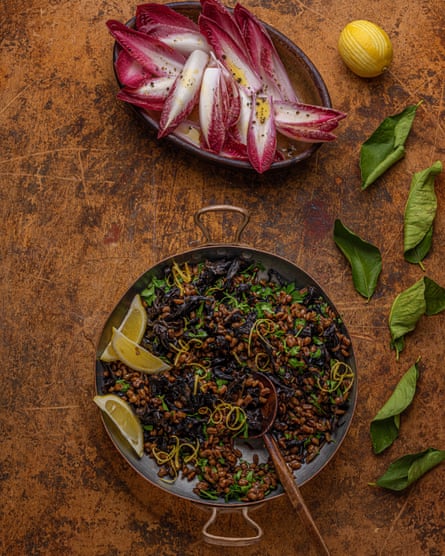
The garlic and parsley chopped together in this vegetarian dish is, almost, the key to its absolutely delicious taste. Its traditional French culinary term is persillade. Something unique happens when these two components are bullied together by a hefty chop until almost a vivid green paste; the chopping board will need a good soak in hot soapy water post this agitated activity.
Serves 4
pearl barley 250g, soaked overnight, then washed and well drained
dried black trumpet mushrooms 40g
hot water 600ml, from a recently boiled kettle
butter 50g
onion 1 large, finely chopped
dry vermouth 150mls
salt and pepper
flat-leaf parsley 50g, picked
garlic 3 large cloves, crushed
lemon grated zest of ½
lemon juice a squeeze (optional)
Preheat the oven to 180C/gas mark 4. Cover the trumpet mushrooms with the water and leave to soak for about 30 minutes. Drain them through a colander over a bowl, then further squeeze out any extra liquid from them with your hands. Reserve the liquid. Melt the butter in a solid-based cooking pot (which comes with a lid) and in it quietly fry the onions until golden. Chop up the mushrooms if they are large (if not, don’t bother) and add to the onions. Allow to stew together for a few minutes, add the vermouth, bring back to a simmer and tip in the barley. Season well and pour the reserved mushroom soaking liquid into the pan through a fine sieve; this ensures that any sandy particles from the mushrooms are caught. Once more, bring back to a simmer, pop on the lid and cook in the oven for about 30-40 minutes, or until the barley is tender and that it is clear all liquid has been fully absorbed.
Chop the parsley and garlic together (see intro), then deftly stir into the barley together with the lemon zest. Spoon directly onto hot plates and, if you like, squeeze a small piece of lemon over each serving. Crisp endive leaves in a punchy mustard vinaigrette would make a fitting accompaniment here.
Onions a la monegasque
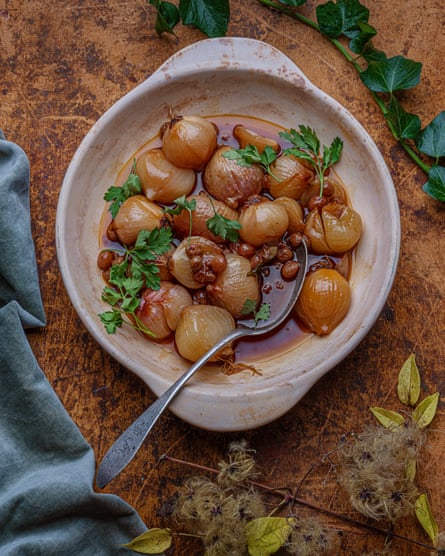
This charming and very tasty recipe is of a kind that will please everyone at the table, and is just the loveliest thing to have around over Christmas; perfect with cold ham and turkey or just on their own, of course. The finest rendering of the dish (its origins may be found among the pages of Elizabeth David) were those cooked by Stephen Markwick at my 50th birthday party.
Serves 4
small pickling onions 500g, or shallots
red wine vinegar 100ml
water 175ml
olive oil 100ml
tomato puree 1 heaped tbsp
bay leaves 2
thyme leaves picked from 2-3 sprigs
parsley 1 small bunch and thyme 3 sprigs, tied together with string
sugar 40g
sultanas 50g
salt and pepper
extra parsley finely chopped
Put the onions (or shallots) into a bowl, pour boiling water over them and leave to soak for 5 minutes. Drain and run them under the cold tap. Peel the onions and cut a shallow cross at each end (this helps to prevent them bursting).
Place all the ingredients in a pan that ensures the onions are submerged, bring to the boil, cover the pan, and cook very, very gently for about 1-1½ hours until the onions are tender and bathed in a thick sauce. (This could also be done in a preheated 140C/gas mark 1.) Remove the bay leaves and parsley and thyme, then decant into a shallow dish and leave to cool. Just before serving, sprinkle with plenty of chopped parsley.
Marsala custards with amaretti crumbs

Yet another delicious new dish. Having recently unearthed a recipe for a custard using sauternes, I thought how good it would be to adapt this to accommodate a more robust alcohol. Sherry has been done, as it were, so it is to the similarly fortified marsala that seemed particularly apt, here. There is little doubt that it is festivity in a glass: deeply aromatic, delicately sweet and with a subtle, raisin-like flavour that whispers Christmas. A perfect way in which to complete this marathon celebration.
Serves 4
egg yolks 6
caster sugar 50g
vanilla paste 1 scant tsp
sea salt a pinch
whipping cream 300ml
marsala 100ml
amaretti liqueur 1 tbsp (optional)
amaretti biscuits 8-10, evenly ground to crumbs
icing sugar a little
Whisk the egg yolks in a bowl together with the sugar, vanilla paste and salt until thick, pale and creamy. Warm the cream with the vanilla then leave to cool a little. Whisk the marsala and amaretti liqueur (if using) into the egg mixture, then incorporate the cream, further whisking together as you go, until well blended. Leave in the bowl until any surface bubbles have dissipated – about 20 minutes.
Preheat the oven to 150C/gas mark 2. Take 4 ramekins (about 100-120ml each) and divide the mixture equally between them. Place the ramekins in a deep roasting dish and pour tap-hot water around them so it comes up just shy of the surface of the custard mixture.
Loosely cover the dish with a sheet of foil – do not clamp its edges to the tin – and carefully slide it into the oven. Bake for around 30-35 minutes, or until just set; give them a little shake and if they wobble nicely they are done.
Remove from the oven, lift off the foil and then leave the custards in the water for about 10 more minutes before removing to cool completely. Cover each one with a tight piece of clingfilm and place in the fridge for at least 4 hours.
To serve, carefully cover the surface of each custard with an even layer of the amaretti crumbs, then lightly dust with icing sugar, just to pretty them. If you like – and I do – take a blow torch and, with a low flame, very gingerly toast the sugared crumbs for half a minute, or until they smell toasty and the sugar is lightly burnished. Serve at once – and eat with teaspoons, please.
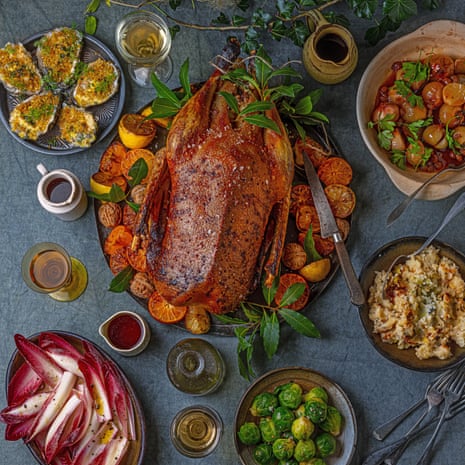
Comments (…)
Sign in or create your Guardian account to join the discussion